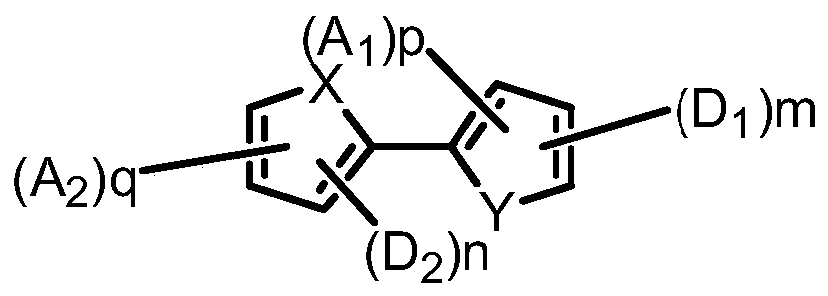Compound, display panel and display apparatus
A technology of compounds and derivatives, applied in the field of organic electroluminescent materials, to achieve the effects of high triplet energy level, high-efficiency energy transfer, and improved luminous efficiency
- Summary
- Abstract
- Description
- Claims
- Application Information
AI Technical Summary
Problems solved by technology
Method used
Image
Examples
Embodiment 1
[0102] Synthesis of Compound P7
[0103]
[0104]S1 (5.0mmol), 9,9-dimethyl-9,10-dihydroacridine S2 (10.4mmol), (dibenzylideneacetone) dipalladium (0) (0.2mmol), sodium tert-butoxide (14.0mmol), 4,5-bisdiphenylphosphine-9,9-dimethylxanthene (0.2mmol) were put into a 250mL three-necked flask, and while stirring, the degassing and nitrogen replacement were repeated 3 times rapidly, and passed Add 50 mL of toluene to the syringe. The mixture was heated to reflux for 3 hours under a stream of nitrogen. After the reaction, water was added to the reaction solution left to cool to room temperature, extracted with dichloromethane, and washed with saturated brine. After the organic layer was dried over anhydrous sodium sulfate, the solvent was distilled off and purified by column chromatography to obtain P7 (3.4 mmol, 68%).
[0105] MALDI-TOF MS: Calculated m / z: C 42 h 28 N 6 S 2 : 680.2; measured value: 680.5.
[0106] Elemental Analysis Calculated: C, 74.09; H, 4.15; N, 12...
Embodiment 2
[0108] Synthesis of Compound P23
[0109]
[0110] Under nitrogen protection, weigh compound S3 (7.5mmol), S4 (15.5mmol), [Pd 2 (dba) 3 ]·CHCl 3 (0.3mmol) and HP(tBu) 3 ·BF 4 (0.6mmol), was added to a 250mL two-neck flask. Inject 100mL of toluene into the two-necked flask (pass N in advance 2 15min to remove oxygen), and then added dropwise 12mL concentration of 1M K 2 CO 3 Aqueous solution (pass N in advance 2 15min except oxygen), stirred overnight at room temperature. After the reaction was completed, 100 mL of deionized water was added, and then 2 mL of 2M HCl was added dropwise. Extract with dichloromethane, collect the organic phase, and wash with anhydrous Na 2 SO 4 Dry processing. The dried solution was filtered, and the solvent was removed by a rotary evaporator to obtain a crude product. The crude product was purified by silica gel column chromatography, and the final purification afforded solid S5 (5.6 mmol, 75%).
[0111] MALDI-TOF MS: m / z calcd:...
Embodiment 3
[0117] Synthesis of Compound P29
[0118]
[0119] S7 (2.7mmol), 9,9-dimethyl-9,10-dihydroacridine S2 (5.7mmol), (dibenzylideneacetone) dipalladium (0) (0.35mmol), sodium tert-butoxide (10.0mmol) and tri-tert-butylphosphine tetrafluoroborate (0.7mmol) were put into a 500mL three-neck flask, while stirring, degassing and nitrogen replacement were repeated three times rapidly, and 200mL toluene was added through a syringe. The mixture was heated to reflux for 3 hours under a stream of nitrogen. After the reaction, water was added to the reaction solution left to cool to room temperature, extracted with dichloromethane, and washed with saturated brine. After drying the organic layer with anhydrous sodium sulfate, the solvent was distilled off and purified by column chromatography to obtain P23 (1.60 mmol, 59%).
[0120] MALDI-TOF MS: m / z calculated: C38H30Br2N2S2: 736.0; measured: 736.2
[0121]
[0122] In a 250ml three-necked flask, first, S9 (7.5mmol), pinacol diborat...
PUM
 Login to View More
Login to View More Abstract
Description
Claims
Application Information
 Login to View More
Login to View More - R&D
- Intellectual Property
- Life Sciences
- Materials
- Tech Scout
- Unparalleled Data Quality
- Higher Quality Content
- 60% Fewer Hallucinations
Browse by: Latest US Patents, China's latest patents, Technical Efficacy Thesaurus, Application Domain, Technology Topic, Popular Technical Reports.
© 2025 PatSnap. All rights reserved.Legal|Privacy policy|Modern Slavery Act Transparency Statement|Sitemap|About US| Contact US: help@patsnap.com



